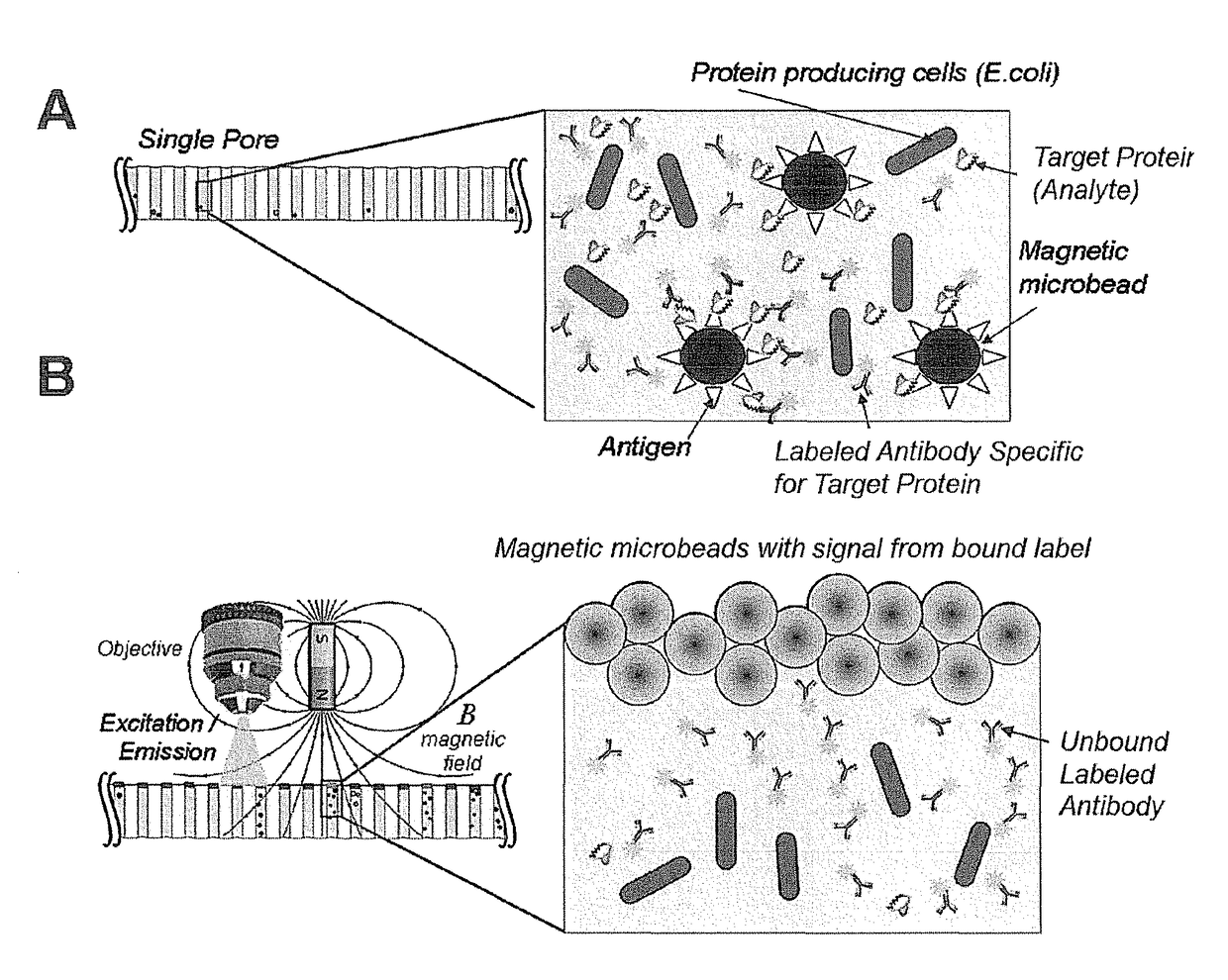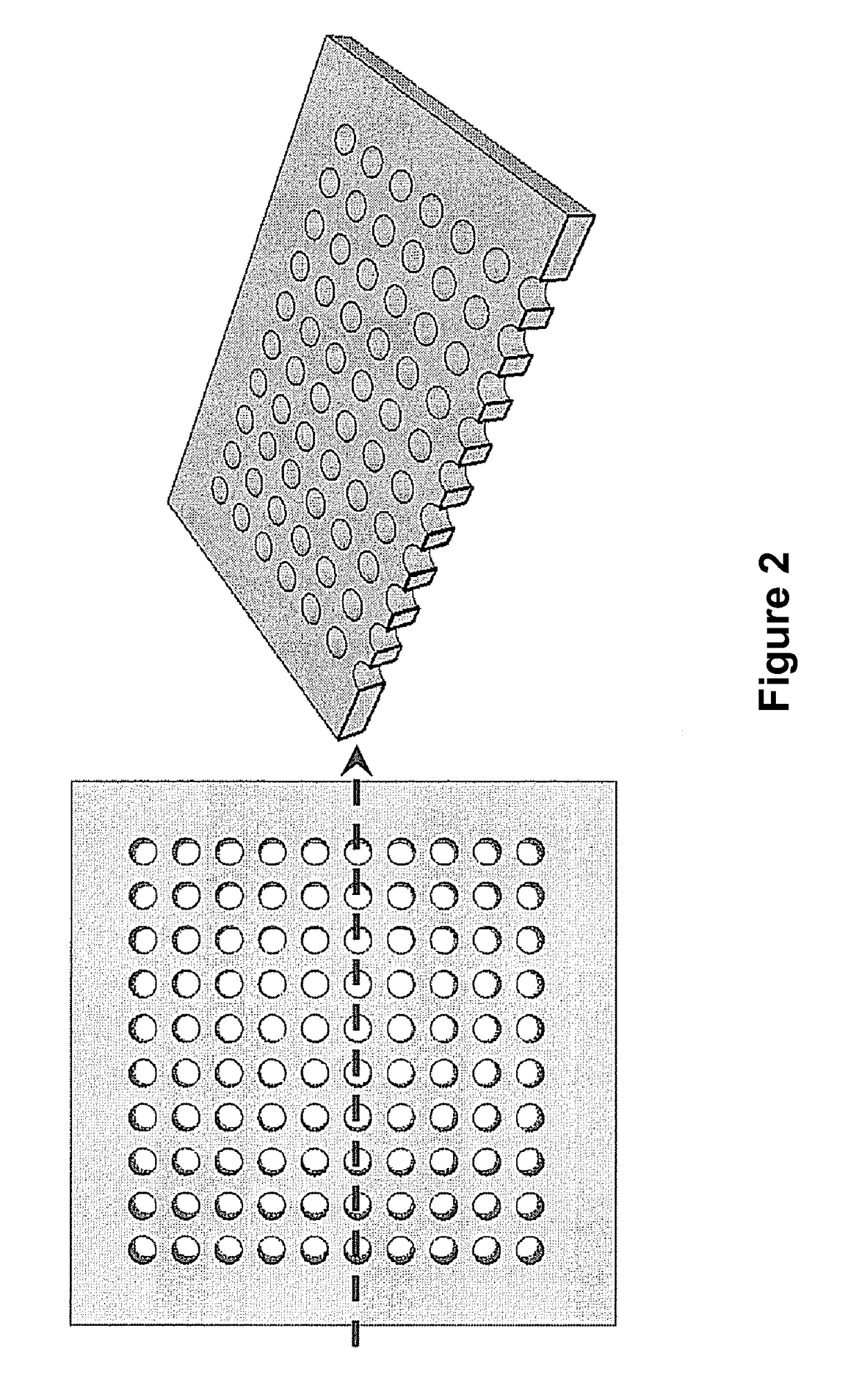Scalable bio-element analysis
a bioelement and element technology, applied in the field of scalable bioelement analysis, can solve the problems of difficult to establish the precise origin of a positive signal, loss of potential binding candidates, and low screening efficiency, and achieve the goal of facilitating high throughput screening techniques to selectively isolate and purify identified clones for rapid application to disease diagnostics and therapeutics.
- Summary
- Abstract
- Description
- Claims
- Application Information
AI Technical Summary
Benefits of technology
Problems solved by technology
Method used
Image
Examples
example 1
Magnetic Bead Signal Blocking
[0178]This example demonstrates the ability of the magnetic beads to inhibit the high background signal from labels in solution that are not bound to the particles.
[0179]A clean and dry 20 μm pore diameter array plate (J5022-19, Hamamatsu Photonics K. K.) was loaded with 10 μM Alexa 488 fluorochrome (Sigma Aldrich) as a label and 2.8 μm magnetic particles such that each pore receives both labels and magnetic particles. The fluorochrome label alone does not bind or associate with the magnetic bead particles.
[0180]The pores of the array are not exposed to any motive force prior to detection, so both the magnetic particles and the labels both remain in solution. Following incubation, this array comprising the magnetic particles and labels is subjected to EM radiation and the fluorescent emission from the label is imaged using a microscope. As expected, as shown in FIG. 5A, all of the pores show significant signal, for the unbound labels in solution have ful...
example 2
Assay Preparation
[0182]This example provides a representative assay system for detecting the presence or absence of an analyte in an array. The final screening design will, of course, depend on many factors specific to the experiment and its objectives.
[0183]The E. coli strain Imp4213, which contains a plasmid expressing GFP, was used in this assay. Approximately 1.0 to 10 million GFP-expressing bacterial cells were added into 5 mL of Luria broth (LB) media with 25 μg / ml kanamycin (KAN) and expanded on a shaker (200 RPM) at 37° C. for approximately 3 hours until the bacteria entered the exponential growth phase, and then were prepared for plating.
[0184]The particles used in this example are magnetic beads. Specifically, for these examples, the particles used were 2.8 μm diameter magnetic beads (Dynabeads) coupled to a either streptavidin (Part No. 112-05D, Invitrogen, Carlsbad, Calif.) or oligo(dt)25 ligands (Part No. 610-05, Invitrogen, Carlsbad, Calif.). The magnetic beads were in...
example 3
Single Cell Specific Detection
[0194]The following example demonstrates the specificity of the disclosed methods for detecting analytes at the single cell level.
[0195]In this embodiment, the assay system is set up according to the steps described in Example 2, except that before the cells are plated, the bacterial cells were diluted to 300 cells per microliter, which was calculated to result in approximately 0.1 cell per pore on the array plate with pores having a 20 micrometer diameter. When added to the array, this dilution will yield up to a single bacterial cell in most pores.
[0196]The anti-GFP streptavidin beads and anti-GFP label were added to the first array as described. The corresponding signal seen when EM radiation is exposed to the array following magnetic bead accumulation is shown in FIG. 7A. Many cells are signal-producing, which represents fluorescent signal from streptavidin magnetic beads that are bound to biotinylated anti-GFP antibody via streptavidin-biotin linka...
PUM
| Property | Measurement | Unit |
|---|---|---|
| diameter | aaaaa | aaaaa |
| diameter | aaaaa | aaaaa |
| diameter | aaaaa | aaaaa |
Abstract
Description
Claims
Application Information
 Login to View More
Login to View More - R&D
- Intellectual Property
- Life Sciences
- Materials
- Tech Scout
- Unparalleled Data Quality
- Higher Quality Content
- 60% Fewer Hallucinations
Browse by: Latest US Patents, China's latest patents, Technical Efficacy Thesaurus, Application Domain, Technology Topic, Popular Technical Reports.
© 2025 PatSnap. All rights reserved.Legal|Privacy policy|Modern Slavery Act Transparency Statement|Sitemap|About US| Contact US: help@patsnap.com



